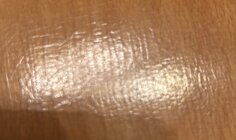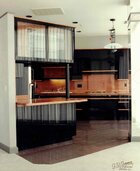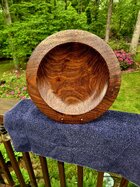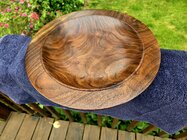I started another finish based thread a minute ago, and this thought came into my head while writing it. I have tried, and struggled with, achieving a nice glossy finish on my pieces. Maybe to qualify this even more...I am not jsut talking "shiny"...which is achievable to a degree with many finishes, and a lot easier. More specifically, I am thinking GLASSY GLOSS, where the piece is VERY glossy, maybe even mirror finish glossy. I've seen a lot of pieces like this and they often look quite appealing, and at least on some things, I wish I could achieve the same kind of finish on my own pieces. I do like a good satin sheen on most things, but I'd like to expand my skills to include the ability to create a good glassy gloss when a piece warrants it (or when a customer might explicitly want it.)
I tried a lot in the spring last year, particularly with polyurethane and spar urethane, but also oil. With the urethanes, the challenge I always seem to have is streaking or dripping. With oil, by the time I seem to get enough oil on a piece for it to even start getting glossy, it looks like "it has too much oil!" I spent a lot of time trying a variety of different techniques to apply poly and spar, from brushing on with bristle brushes, then foam brushes, then thinning and brushing, then using a foam brush to apply in a very specific manner while the piece was turning at about 50rpm...
I did learn a few really good lessons.
FIRST: Make sure you sand the surface of the wood so its very smooth and clean. Any defects in the wood surface, seem to just get compounded once you start layering on poly or spar urethanes. In fact, with each additional coat, defects only seem to become more and more pronounced! (Honestly not sure why...)
SECOND: DO NOT leave the drying piece anywhere it can pick up dust or other particulate, as IT WILL! Dust and particulate usually lead me to have to cut back the surface of the previous coat, once fully dried, requiring another coat. Then there was always the risk that coat would pick junk up. It seems to take a good 12 hours for a coat to dry well enough and hard enough that it can be scuffed back properly for another coat, which leads to a very LONG finishing process...
THIRD: DO NOT mess with poly or spar after its started to settle, as once it starts to dry, messing with it will only introduce ripples or other defects that will not level out like the initial brush/applicator strokes.
Despite learning these things, I still struggle getting a good, flat, ripple-free, defect-free poly or spar urethane finish. Even if I try to use a satin rather than a gloss, getting DEFECT FREE finishes with these seems challenging.
I then tried just pure oils, but mostly drying oils like Danish or Tung w/ drying agents. Pure oils, just seem to take longer than I can comprehend, to actually dry. I think I spent about 30 days trying to coat a piece in pure linseed oil and get a glossy result, and it just didn't happen. With the drying oils, I started with danish, and on its own I don't think it was possible to get a glossy surface just by adding coats. I did eventually find some videos where people would coat with danish repeatedly for a few days, several times a day, then BUFF it to get more of a shiny appearance...but this was more of a satin sheen, not a glassy gloss. I started experimenting with Tung Oil, a drying one, late last year, and as I built up coats, it seemed like it might actually be able to achieve a nice, good, very glossy finish. However, it suffers from some of the same issues as the urethanes, notably that it picks up all kinds of dusty junk. I thought about placing it in some kind of container to keep the dust off of it, but then you end up starving the finish of the oxygen it needs to cure... I did eventually build up a decent amount of tung oil on a couple of pieces, and while they did appear to be getting shinier, there was something about it that just didn't look...good. It is entirely possible, and likely, that the problem was me and that I wasn't applying the finish properly.
I'm curious how those of you who do achieve good, clear, glassy gloss finishes achieve them, and with what finishes? Are you using just an oil, or a poly, or something else? How do you achieve those beautiful, smooth, mirror glass like results in the end?
I tried a lot in the spring last year, particularly with polyurethane and spar urethane, but also oil. With the urethanes, the challenge I always seem to have is streaking or dripping. With oil, by the time I seem to get enough oil on a piece for it to even start getting glossy, it looks like "it has too much oil!" I spent a lot of time trying a variety of different techniques to apply poly and spar, from brushing on with bristle brushes, then foam brushes, then thinning and brushing, then using a foam brush to apply in a very specific manner while the piece was turning at about 50rpm...
I did learn a few really good lessons.
FIRST: Make sure you sand the surface of the wood so its very smooth and clean. Any defects in the wood surface, seem to just get compounded once you start layering on poly or spar urethanes. In fact, with each additional coat, defects only seem to become more and more pronounced! (Honestly not sure why...)
SECOND: DO NOT leave the drying piece anywhere it can pick up dust or other particulate, as IT WILL! Dust and particulate usually lead me to have to cut back the surface of the previous coat, once fully dried, requiring another coat. Then there was always the risk that coat would pick junk up. It seems to take a good 12 hours for a coat to dry well enough and hard enough that it can be scuffed back properly for another coat, which leads to a very LONG finishing process...
THIRD: DO NOT mess with poly or spar after its started to settle, as once it starts to dry, messing with it will only introduce ripples or other defects that will not level out like the initial brush/applicator strokes.
Despite learning these things, I still struggle getting a good, flat, ripple-free, defect-free poly or spar urethane finish. Even if I try to use a satin rather than a gloss, getting DEFECT FREE finishes with these seems challenging.
I then tried just pure oils, but mostly drying oils like Danish or Tung w/ drying agents. Pure oils, just seem to take longer than I can comprehend, to actually dry. I think I spent about 30 days trying to coat a piece in pure linseed oil and get a glossy result, and it just didn't happen. With the drying oils, I started with danish, and on its own I don't think it was possible to get a glossy surface just by adding coats. I did eventually find some videos where people would coat with danish repeatedly for a few days, several times a day, then BUFF it to get more of a shiny appearance...but this was more of a satin sheen, not a glassy gloss. I started experimenting with Tung Oil, a drying one, late last year, and as I built up coats, it seemed like it might actually be able to achieve a nice, good, very glossy finish. However, it suffers from some of the same issues as the urethanes, notably that it picks up all kinds of dusty junk. I thought about placing it in some kind of container to keep the dust off of it, but then you end up starving the finish of the oxygen it needs to cure... I did eventually build up a decent amount of tung oil on a couple of pieces, and while they did appear to be getting shinier, there was something about it that just didn't look...good. It is entirely possible, and likely, that the problem was me and that I wasn't applying the finish properly.
I'm curious how those of you who do achieve good, clear, glassy gloss finishes achieve them, and with what finishes? Are you using just an oil, or a poly, or something else? How do you achieve those beautiful, smooth, mirror glass like results in the end?





